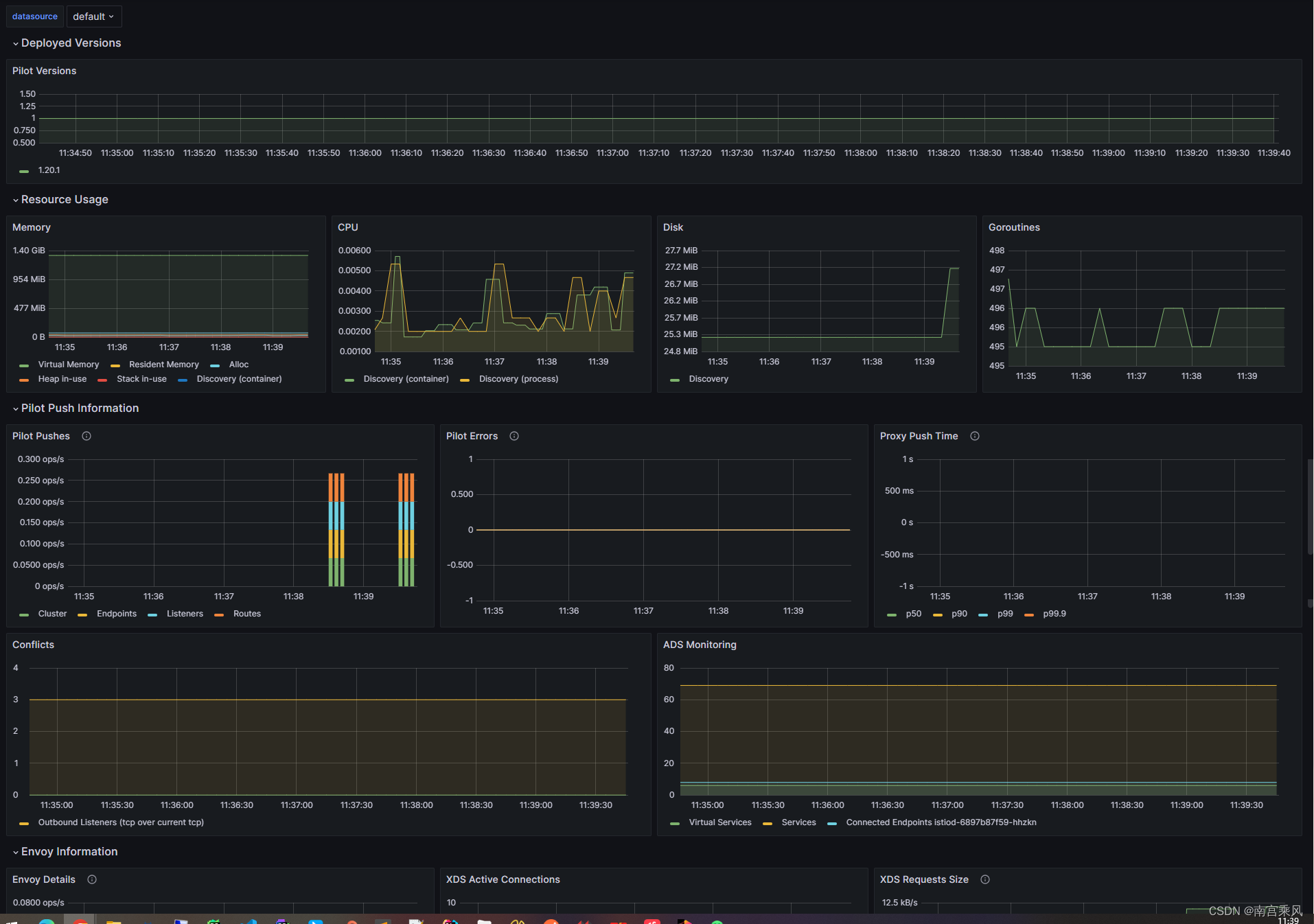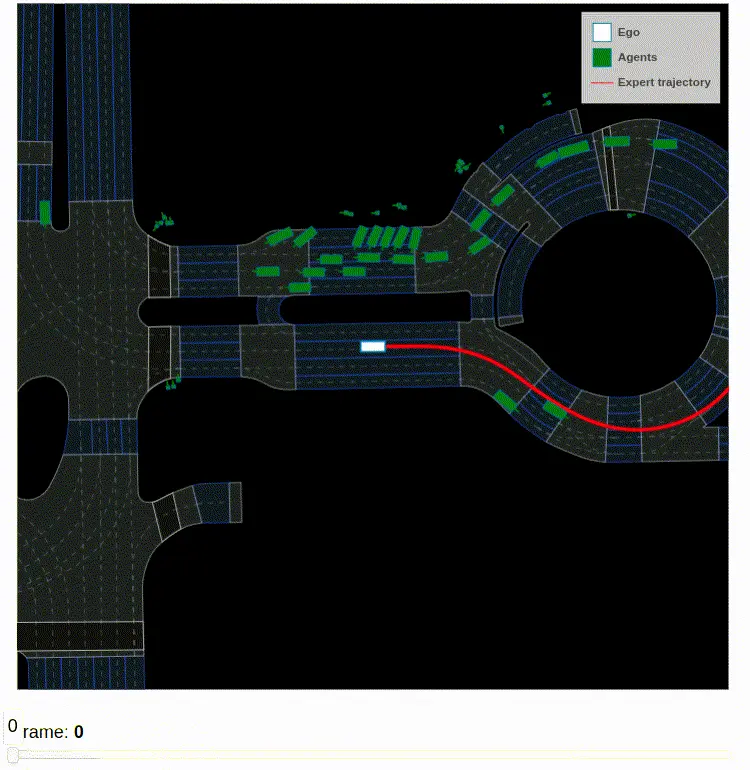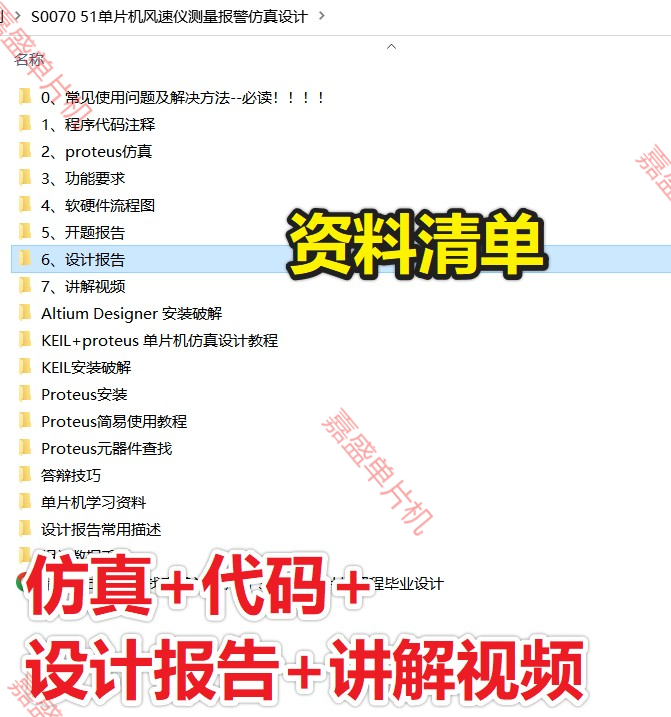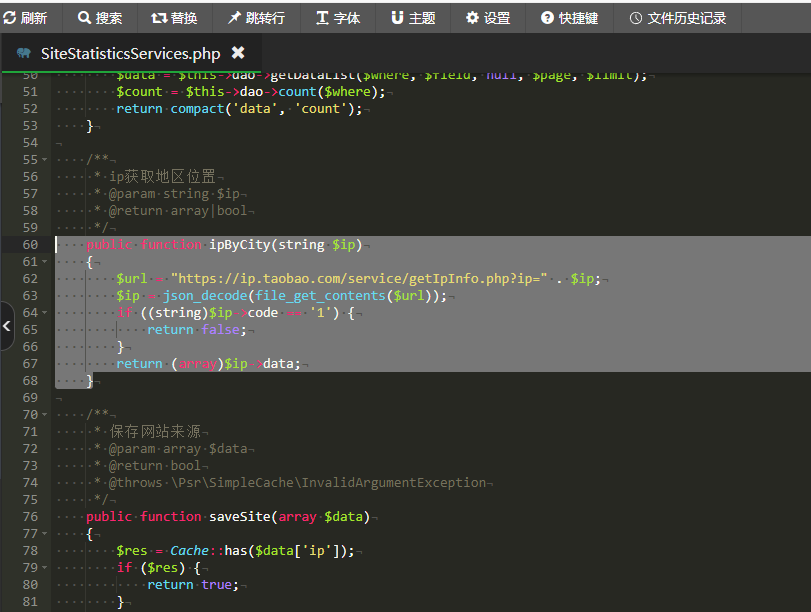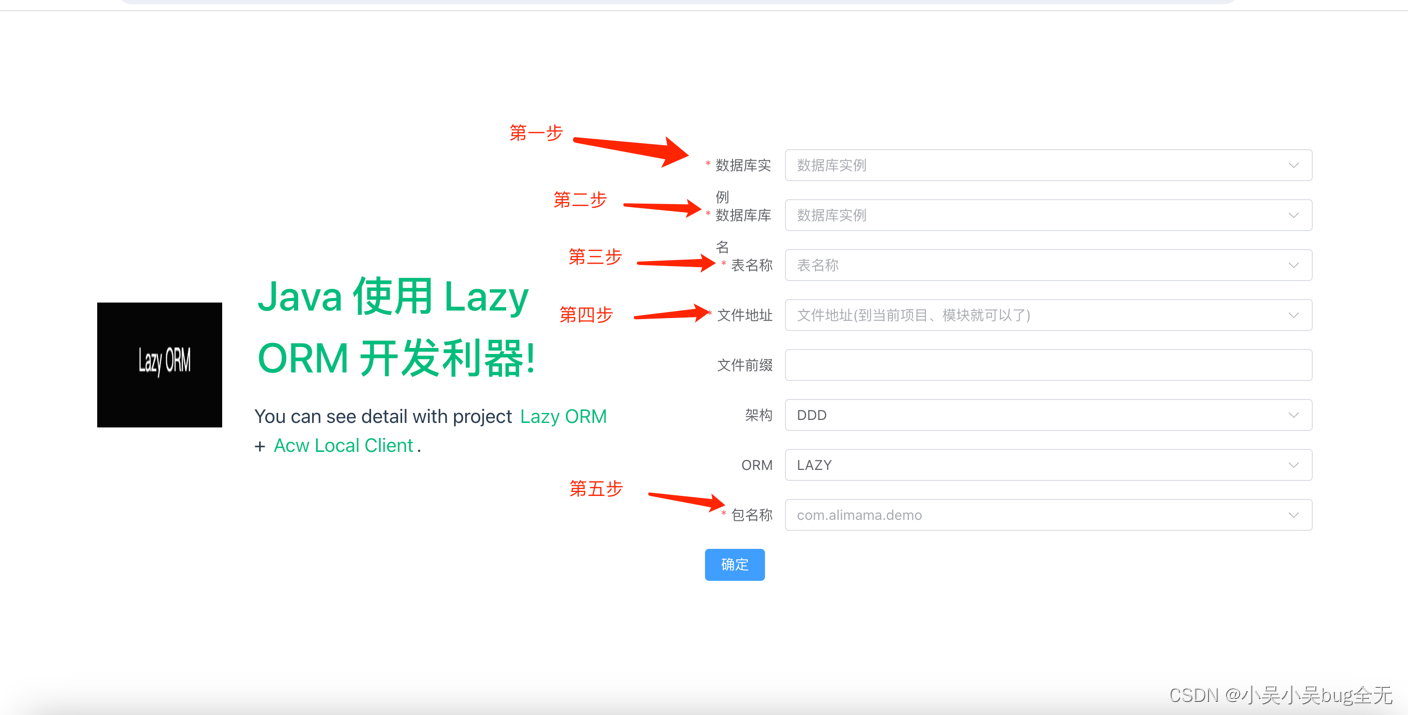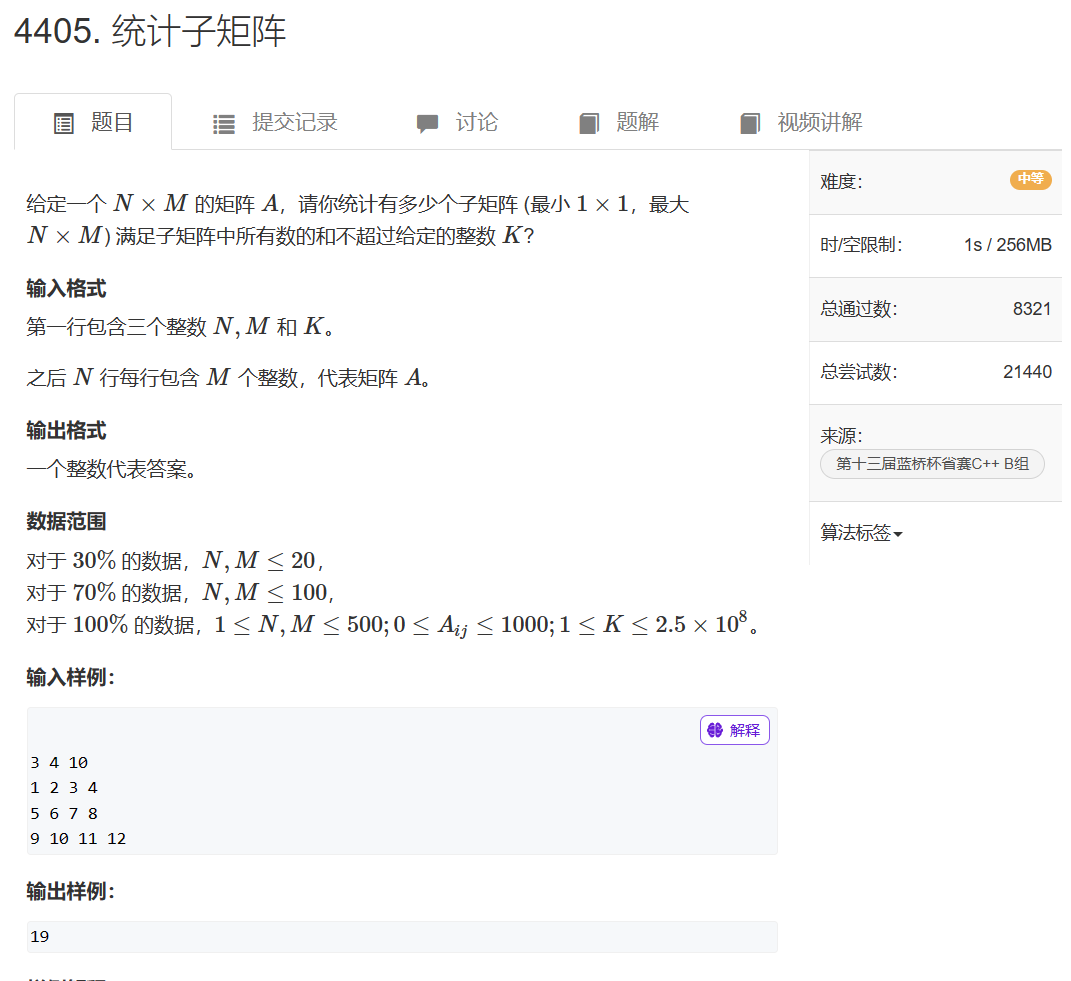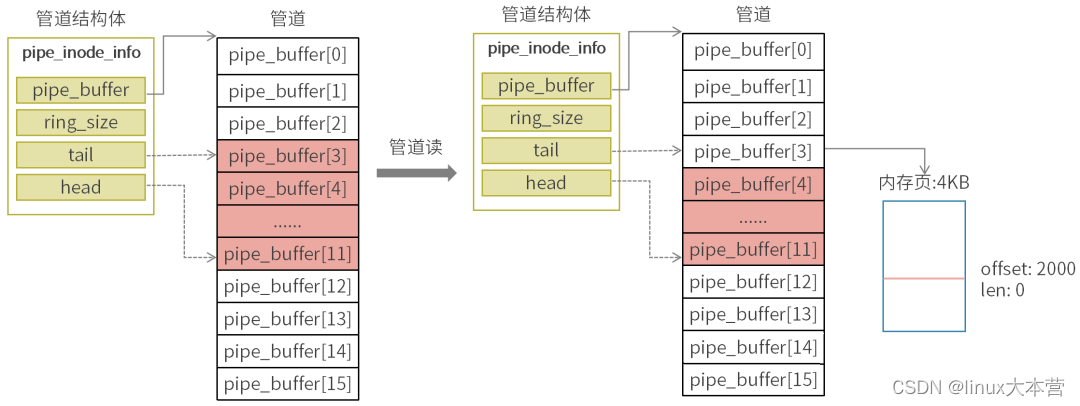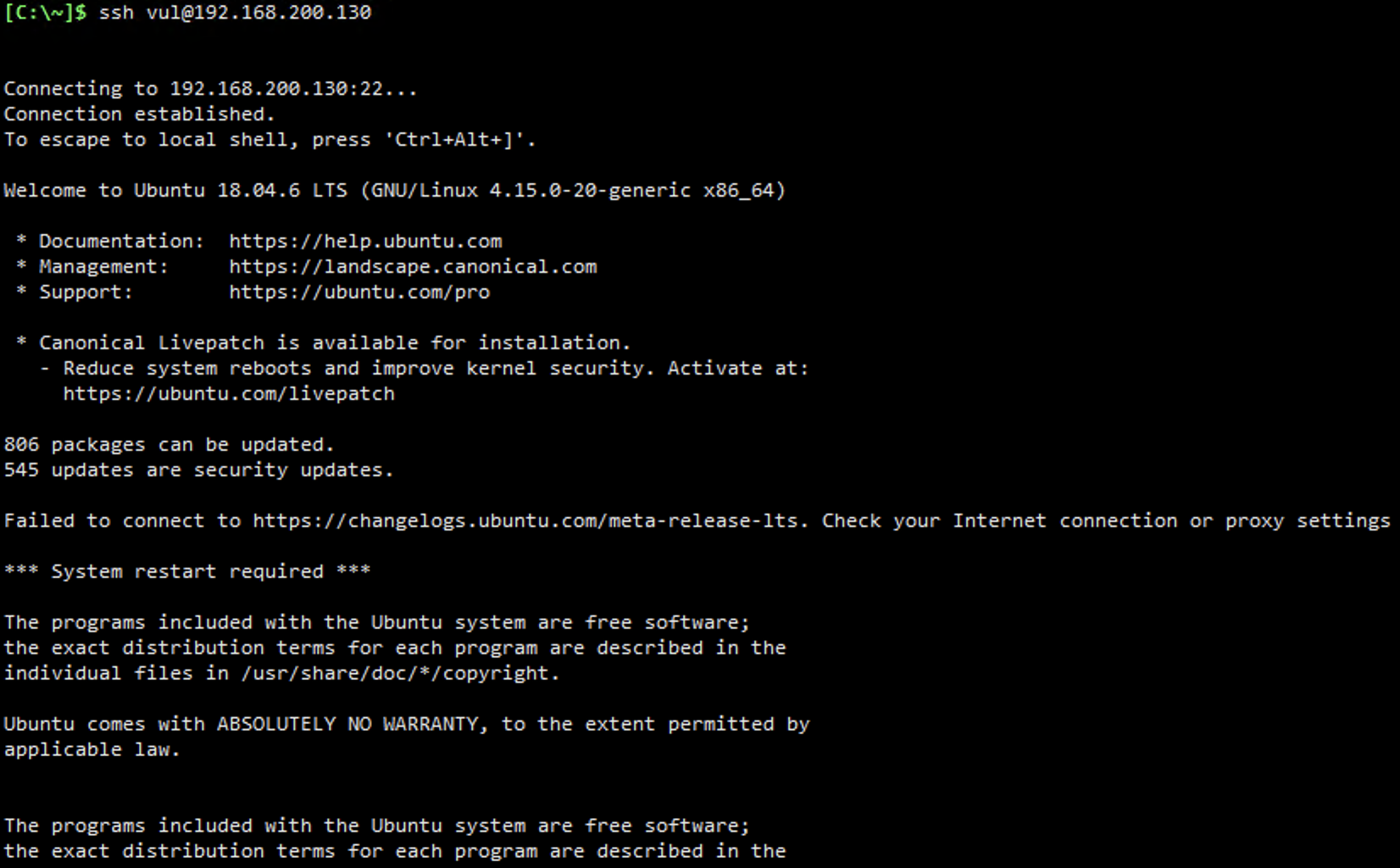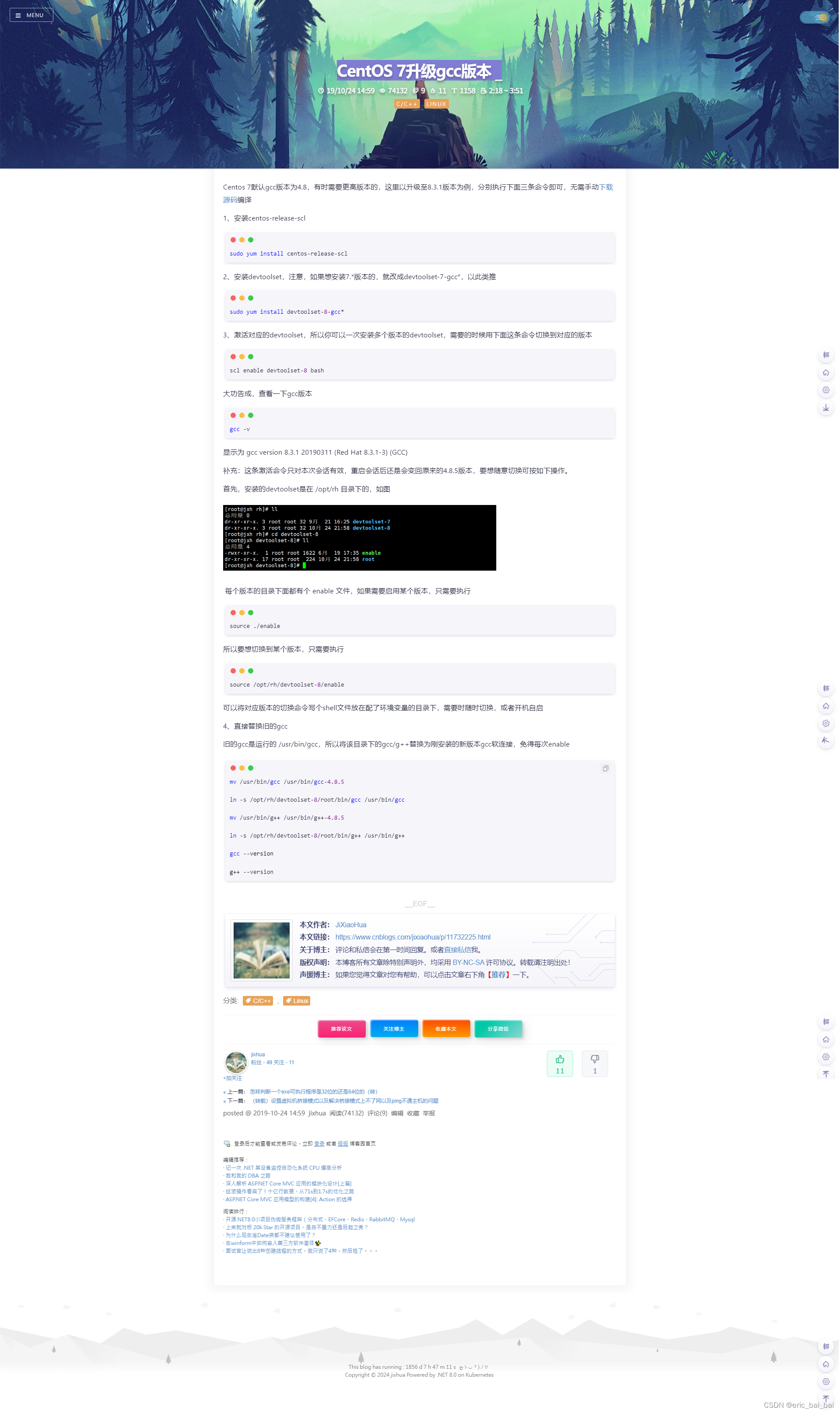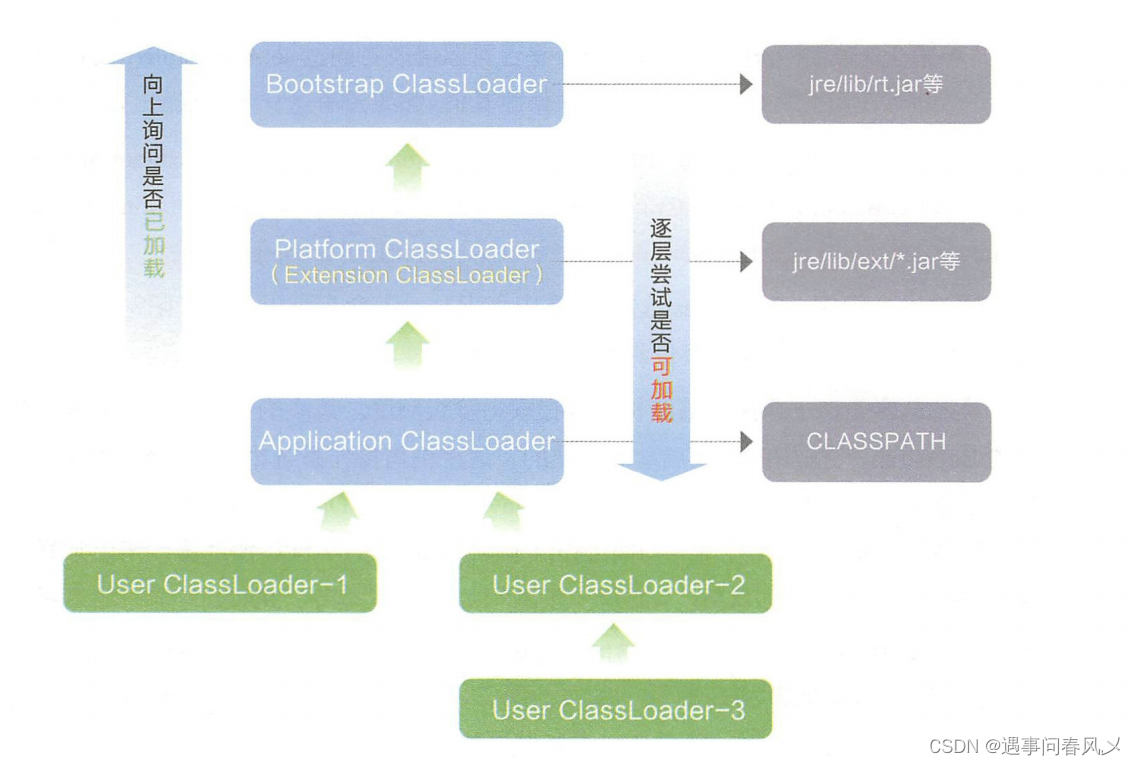1. 搭建商品详情微服务
当用户搜索到商品后,如果想要了解商品的更多信息,就需要进入商品详情页。
由于商品详情浏览量比较大,所以我们会创建一个微服务,用来展示商品详情。我们的商品详情页会采用 Thymeleaf 模板引擎渲染后,再返回到客户端。
1.1 创建工程
-
右键 leyou 项目 --> New Module --> Maven --> Next
-
填写项目信息 --> Next
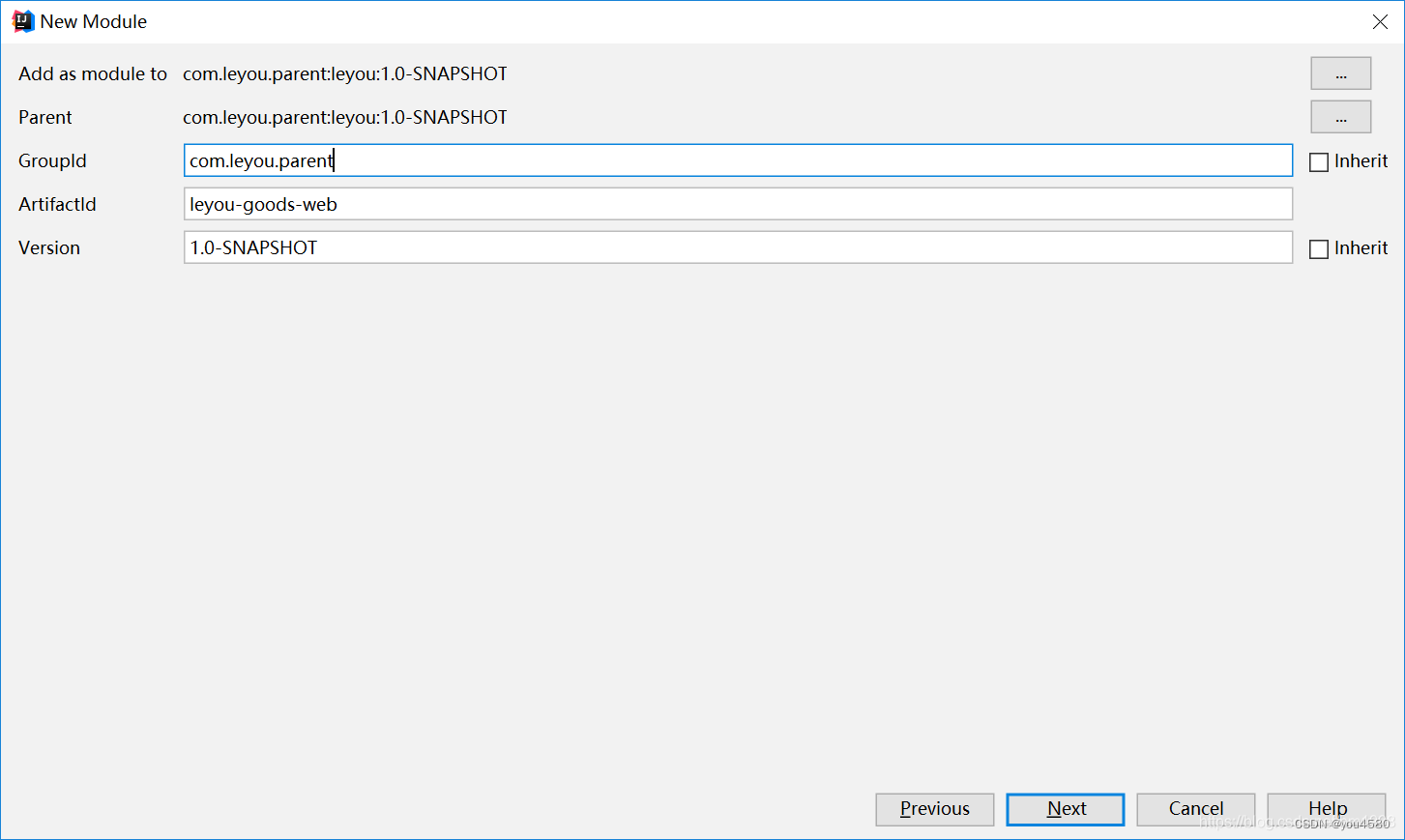
3.填写保存的位置 --> Finish
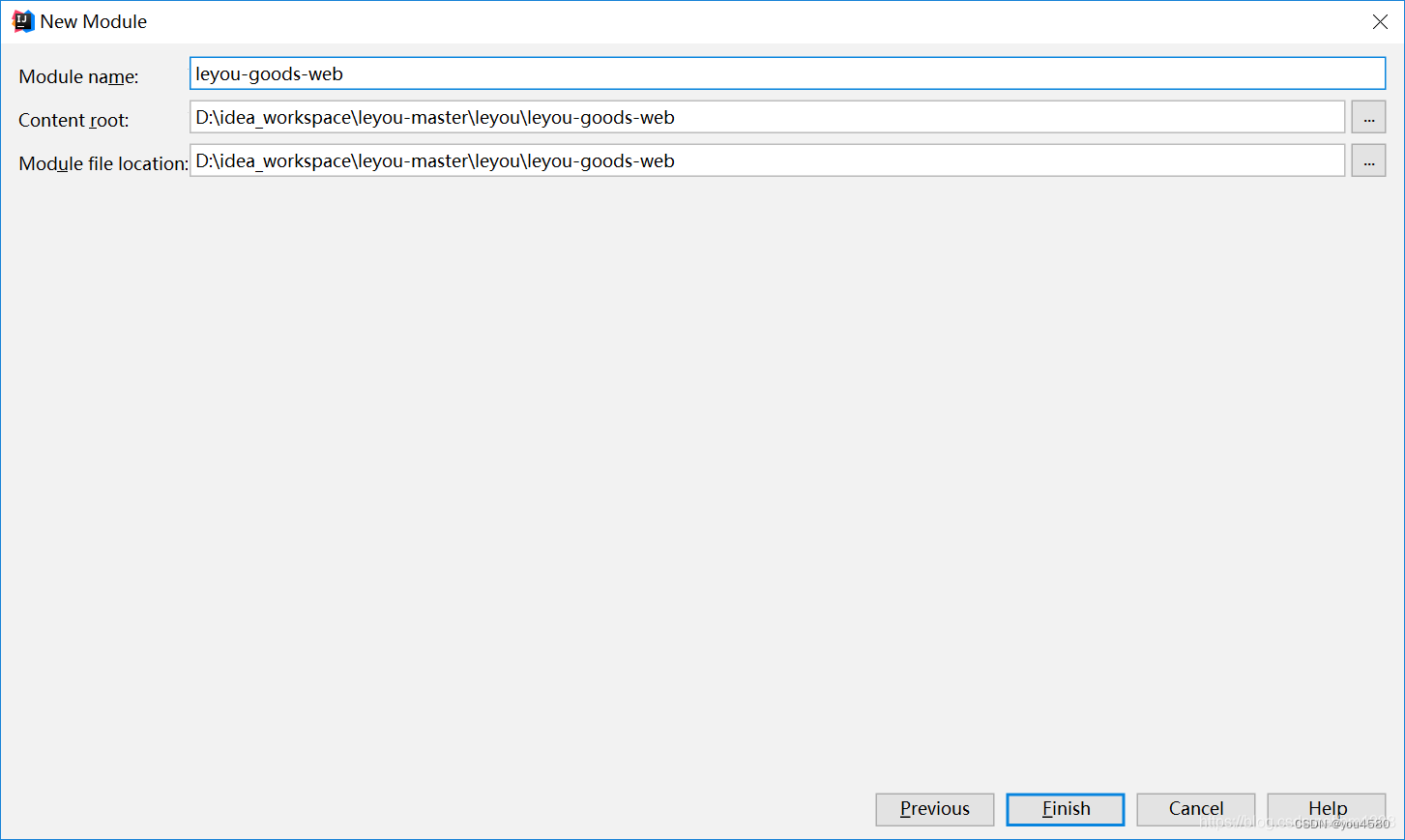
4.添加依赖
<?xml version="1.0" encoding="UTF-8"?>
<project xmlns="http://maven.apache.org/POM/4.0.0"xmlns:xsi="http://www.w3.org/2001/XMLSchema-instance"xsi:schemaLocation="http://maven.apache.org/POM/4.0.0 http://maven.apache.org/xsd/maven-4.0.0.xsd"><parent><artifactId>leyou</artifactId><groupId>com.leyou.parent</groupId><version>1.0-SNAPSHOT</version></parent><modelVersion>4.0.0</modelVersion><groupId>com.leyou.parent</groupId><artifactId>leyou-goods-web</artifactId><version>1.0-SNAPSHOT</version><dependencies><dependency><groupId>org.springframework.boot</groupId><artifactId>spring-boot-starter-web</artifactId></dependency><dependency><groupId>org.springframework.boot</groupId><artifactId>spring-boot-starter-thymeleaf</artifactId></dependency><dependency><groupId>org.springframework.cloud</groupId><artifactId>spring-cloud-starter-netflix-eureka-client</artifactId></dependency><dependency><groupId>org.springframework.cloud</groupId><artifactId>spring-cloud-starter-openfeign</artifactId></dependency><dependency><groupId>com.leyou.common</groupId><artifactId>leyou-common</artifactId><version>1.0-SNAPSHOT</version></dependency><dependency><groupId>com.leyou.item</groupId><artifactId>leyou-item-interface</artifactId><version>1.0-SNAPSHOT</version></dependency><dependency><groupId>org.springframework.boot</groupId><artifactId>spring-boot-starter-test</artifactId></dependency></dependencies>
</project>
5.编写配置文件 application.yaml
server:port: 8084
spring:application:name: goods-web-servicethymeleaf:cache: false
eureka:client:service-url:defaultZone: http://localhost:10086/eurekainstance:lease-renewal-interval-in-seconds: 5lease-expiration-duration-in-seconds: 10
6.编写启动类
@SpringBootApplication
@EnableDiscoveryClient
@EnableFeignClients
public class LeyouGoodsWebApplication {public static void main(String[] args) {SpringApplication.run(LeyouGoodsWebApplication.class, args);}
}1.2 创建页面模板
-
从 leyou-portal 项目中复制 item.html 模板到当前项目 resource 目录下的 templates 中。
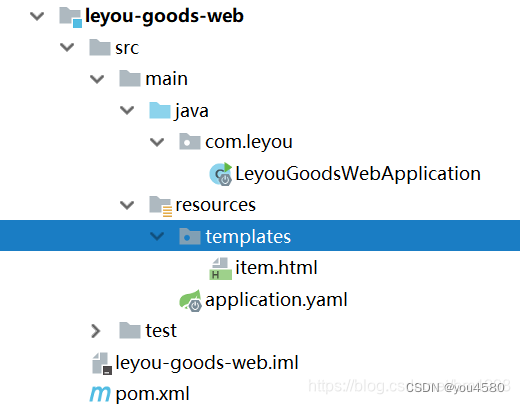
2.把 HTML 的名称空间改成 xmlns:th="http://www.thymeleaf.org",这样页面就由 Thymeleaf 的引擎解析了。

1.3 页面跳转
1.3.1 修改页面跳转路径
当我们点击某个商品图片时,应该携带该商品的 SpuId 跳转到商品详情页。
例如:
http://www.leyou.com/item/2314123.html
我们打开 search.html,修改其中的商品路径:

1.3.2 Nginx 反向代理
接下来,我们要把这个地址指向我们的 leyou-goods-web 服务,其端口为 8084。
我们在 nginx.conf 中添加配置,并重启 Nginx
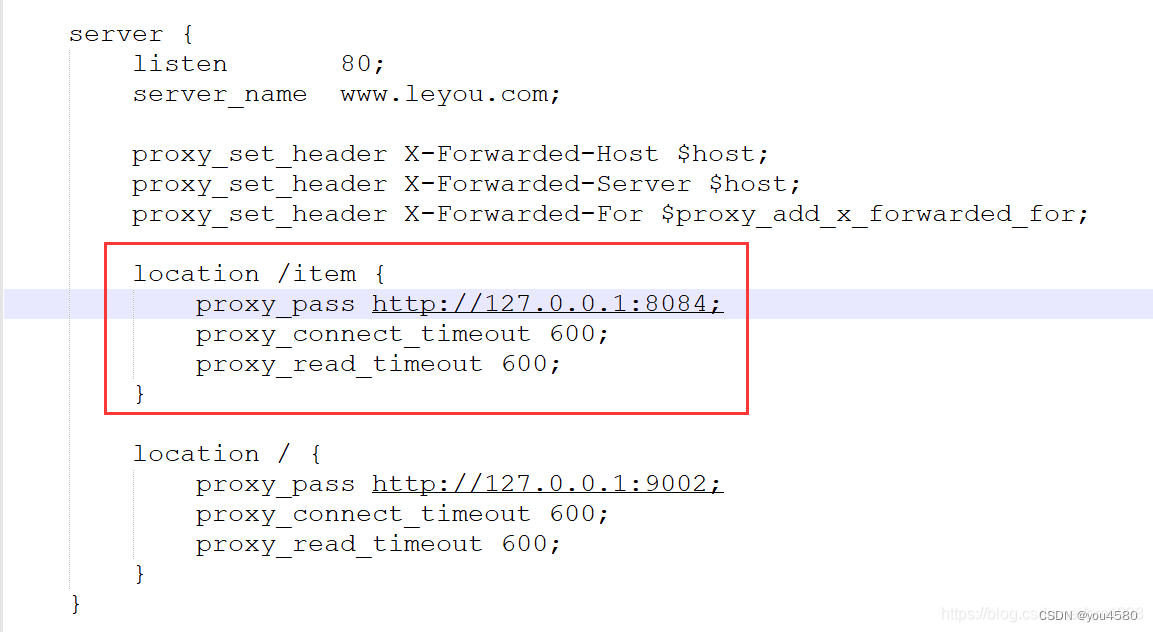
1.3.3 编写 Controller
在 leyou-goods-web 中编写 Controller,接收请求,并跳转到商品详情页
@Controller
@RequestMapping("/item")
public class GoodsController {/*** 跳转到商品详情页** @param model* @param id* @return*/@GetMapping("/{id}.html")public String toItemPage(Model model, @PathVariable("id") Long id) {return "item";}
}
1.3.4 测试
-
启动 leyou-goods-web 工程
-
点击一个搜索到的商品,成功跳转到商品详情页

1.4 后台提供接口
1.4.1 分析模型数据
首先我们一起来分析一下,在这个页面中需要哪些数据。
我们已知的条件是传递来的 Spu 的 id,我们需要根据 Spu 的 id 查询到下面的数据:
- Spu 信息
- Spu 详情
- Spu 下的所有 Sku
- 品牌
- 商品三级分类
- 规格参数组
- 规格参数
1.4.2 商品微服务提供接口
为了查询到上面的数据,我们需要在商品微服务中提供一些接口。
通过 Spu 的 id 查询 Spu
在 SpuApi 接口中添加方法 querySpuById
/*** 通过 spuId 查询 Spu* @param spuId* @return*/
@GetMapping("{spuId}")
public Spu querySpuById(@PathVariable("spuId") Long spuId);
在 SpuController 中添加方法 querySpuById
/*** 通过 spuId 查询 Spu* @param spuId* @return*/
@GetMapping("{spuId}")
public ResponseEntity<Spu> querySpuById(@PathVariable("spuId") Long spuId){Spu spu = spuService.querySpuById(spuId);if (spu == null) {return ResponseEntity.notFound().build();}return ResponseEntity.ok(spu);
}
在 SpuService 中添加方法 querySpuById
/*** 通过 spuId 查询 Spu* @param spuId* @return*/
public Spu querySpuById(Long spuId) {Spu spu = spuMapper.selectByPrimaryKey(spuId);return spu;
}
通过分类 id 查询规格参数组
商品详情页需要展示商品的规格参数组,以及其下的规格参数。所以我们需要提供一个接口,通过 Spu 的 id 查询规格参数组,并将规格参数封装其中。
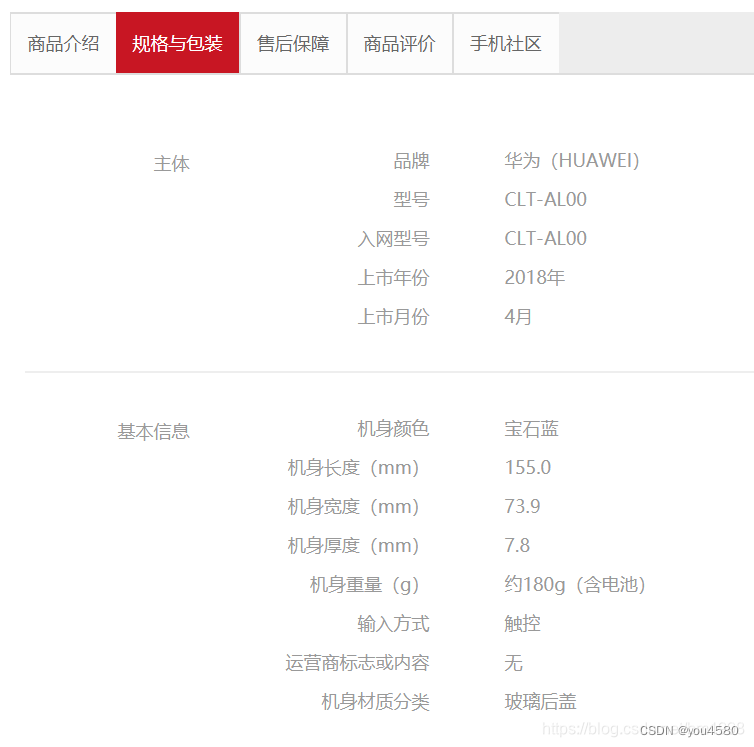
在 SpecificationApi 接口中添加方法 queryGroupWithCid
/*** 通过分类 id 查询规格参数组* @param cid* @return*/
@GetMapping("/group/param/{cid}")
public List<SpecGroup> queryGroupWithCid(@PathVariable("cid") Long cid);
在 SpecificationController 中添加方法 queryGroupsWithParam
/*** 通过分类 id 查询规格参数组** @param cid* @return*/
@GetMapping("/group/param/{cid}")
public ResponseEntity<List<SpecGroup>> queryGroupsWithParam(@PathVariable("cid") Long cid) {List<SpecGroup> specGroups = specificationService.queryGroupsWithParam(cid);if (CollectionUtils.isEmpty(specGroups)) {return ResponseEntity.notFound().build();}return ResponseEntity.ok(specGroups);
}
在 SpecificationService 中添加方法 queryGroupsWithParam
/*** 通过分类 id 查询规格参数组** @param cid* @return*/
public List<SpecGroup> queryGroupsWithParam(Long cid) {List<SpecGroup> specGroups = querySpecGroupsByCid(cid);for (SpecGroup specGroup : specGroups) {List<SpecParam> params = querySpecParams(specGroup.getId(), null, null, null);specGroup.setParams(params);}return specGroups;
}
1.4.3 创建 FeignClient
我们在 leyou-goods-web 服务中,创建 FeignClient
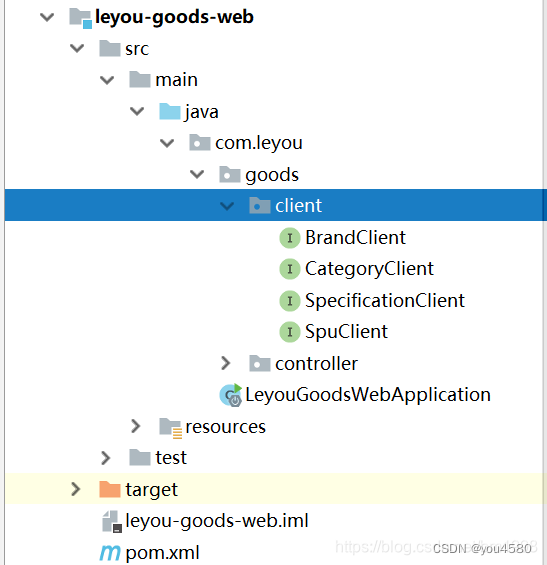
@FeignClient(value = "item-service")
public interface BrandClient extends BrandApi {
}
@FeignClient(value = "item-service")
public interface SpuClient extends SpuApi {
}
@FeignClient(value = "item-service")
public interface CategoryClient extends CategoryApi {
}
@FeignClient(value = "item-service")
public interface SpecificationClient extends SpecificationApi {
}
1.4.4 商品详情微服务提供接口
再来回顾一下商品详情页需要的数据,如下:
- Spu 信息
- Spu 详情
- Spu 下的所有 Sku
- 品牌
- 商品三级分类
- 规格参数组
- 规格参数
我们可以使用 Map<String, Object> 的数据结构封装这些数据,第一个参数为数据名称,第二个参数为数据。
-
在 GoodsController 中查询到所需数据,并放入 model
@Controller
@RequestMapping("/item")
public class GoodsController {@Autowiredprivate GoodsService goodsService;/*** 通过 spuId 查询所需数据** @param model* @param id* @return*/@GetMapping("/{id}.html")public String toItemPage(Model model, @PathVariable("id") Long id) {// 通过 spuId 查询所需数据Map<String, Object> modelMap = this.goodsService.loadData(id);// 放入模型model.addAllAttributes(modelMap);return "item";}
}
在 GoodsService 中添加方法 loadData
@Service
public class GoodsService {@Autowiredprivate BrandClient brandClient;@Autowiredprivate CategoryClient categoryClient;@Autowiredprivate SpuClient spuClient;@Autowiredprivate SpecificationClient specificationClient;/*** 通过 spuId 查询所需数据* @param spuId* @return*/public Map<String, Object> loadData(Long spuId) {Map<String, Object> map = new HashMap<>();// 查询 SpuSpu spu = this.spuClient.querySpuById(spuId);// 查询 SpuDetailSpuDetail spuDetail = this.spuClient.querySpuDetailBySpuId(spuId);// 查询 Sku 集合List<Sku> skus = this.spuClient.querySkusBySpuId(spuId);// 查询分类List<Long> cids = Arrays.asList(spu.getCid1(), spu.getCid2(), spu.getCid3());List<String> names = this.categoryClient.queryNamesByIds(cids);List<Map<String, Object>> categories = new ArrayList<>();for (int i = 0; i < cids.size(); i++) {Map<String, Object> categoryMap = new HashMap<>();categoryMap.put("id", cids.get(i));categoryMap.put("name", names.get(i));categories.add(categoryMap);}// 查询品牌Brand brand = this.brandClient.queryBrandById(spu.getBrandId());// 查询规格参数组List<SpecGroup> groups = this.specificationClient.queryGroupsWithParam(spu.getCid3());// 查询特殊的规格参数List<SpecParam> params = this.specificationClient.querySpecParams(null, spu.getCid3(), false, null);Map<Long, String> paramMap = new HashMap<>();params.forEach(param -> {paramMap.put(param.getId(), param.getName());});// 封装 Spumap.put("spu", spu);// 封装 SpuDetailmap.put("spuDetail", spuDetail);// 封装 Sku 集合map.put("skus", skus);// 封装分类map.put("categories", categories);// 封装品牌map.put("brand", brand);// 封装规格参数组map.put("groups", groups);// 封装特殊规格参数map.put("paramMap", paramMap);return map;}
}1.4.5 测试
-
在 item.html 页面写一段 JS 代码,把模型中的数据取出观察
<script th:inline="javascript">const a = /*[[${groups}]]*/ [];const b = /*[[${params}]]*/ [];const c = /*[[${categories}]]*/ [];const d = /*[[${spu}]]*/ {};const e = /*[[${spuDetail}]]*/ {};const f = /*[[${skus}]]*/ [];const g = /*[[${brand}]]*/ {};
</script>
-
点击一个商品详情页,查看网页源码,成功查到数据
-
在 item.html 页面写一段 JS 代码,把模型中的数据取出观察

1.5 渲染页面
略,交给前端吧。最终效果如下:
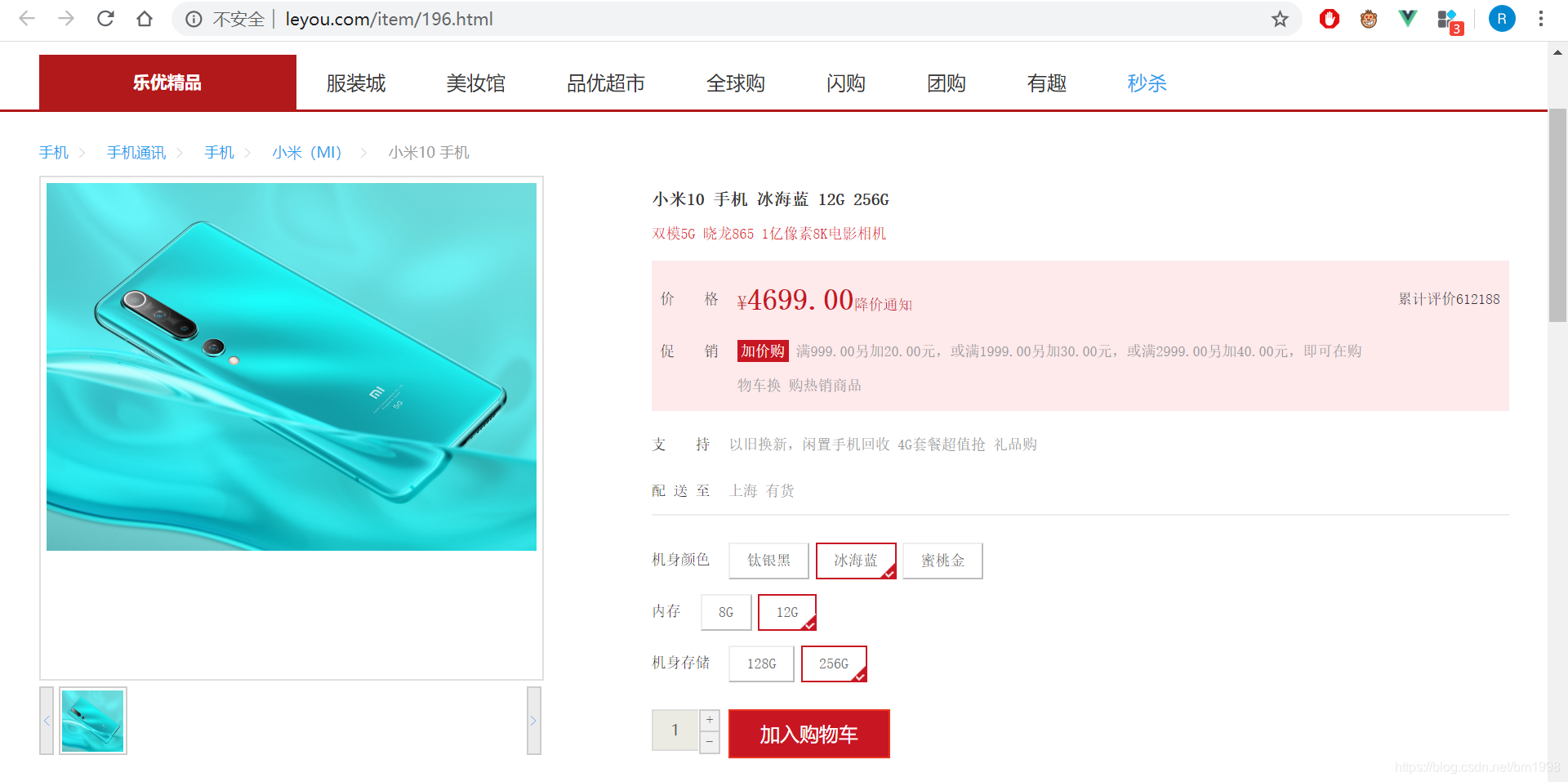

2. 页面静态化
2.1 问题分析
现在我们的商品详情页会采用 Thymeleaf 模板引擎渲染后,再返回到客户端。
但这样在后台需要做大量的数据查询,而后渲染得到 HTML 页面。会对数据库造成压力,并且请求的响应时间过长,并发能力不高。
有没有办法解决这些问题呢?
- 首先,我们能想到的就是缓存技术。比如使用 Redis 缓存,不过 Redis 适合数据规模比较小的情况。假如数据量比较大,比如我们的商品详情页,每个页面如果 10 kb,100 万商品,就是 10 GB 空间,对内存占用比较大,此时就给缓存系统带来极大压力,如果缓存崩溃,接下来倒霉的就是数据库了。
- 其次,可以使用静态化技术。静态化是指把动态生成的 HTML 页面变为静态内容保存,以后用户的请求到来,直接访问静态页面,不再经过服务器的渲染。而静态的 HTML 页面可以部署在 Nginx 中,从而大大提高并发能力。
2.2 如何实现静态化
原来,我们商品详情页通过 Thymeleaf 模板引擎生成后,直接就返回给客户端了。
现在,我们生成商品详情页后,将它先部署一份在 Nginx 中,再返回给客户端。下一次在访问这个页面时,就直接访问 Niginx 中的静态页面
2.3 实现页面静态化
-
在 leyou-goods-web 工程中的 service 包下创建 GoodsHtmlService
@Service
public class GoodsHtmlService {@Autowiredprivate GoodsService goodsService;@Autowiredprivate TemplateEngine templateEngine;/*** 创建 HTML 静态页面** @param spuId* @throws Exception*/public void createHtml(Long spuId) {PrintWriter writer = null;try {// 获取页面数据Map<String, Object> spuMap = this.goodsService.loadData(spuId);// 创建 Thymeleaf 上下文对象Context context = new Context();// 把数据放入上下文对象context.setVariables(spuMap);// 创建输出流File file = new File("D:\\nginx-1.14.0\\html\\item\\" + spuId + ".html");writer = new PrintWriter(file);// 执行页面静态化方法templateEngine.process("item", context, writer);} catch (Exception e) {e.printStackTrace();} finally {if (writer != null) {writer.close();}}}
}
在 GoodsController 中调用页面静态化方法
/*** 通过 spuId 查询所需数据** @param model* @param id* @return*/
@GetMapping("/{id}.html")
public String toItemPage(Model model, @PathVariable("id") Long id) {// 通过 spuId 查询所需数据Map<String, Object> modelMap = this.goodsService.loadData(id);// 放入模型model.addAllAttributes(modelMap);// 页面静态化goodsHtmlService.createHtml(id);return "item";
}
修改 Nginx 配置,使 Nginx 代理静态页面。让它对商品请求进行监听,先指向本地静态页面,如果本地没找到,才反向代理到商品详情微服务。
server {listen 80;server_name www.leyou.com;proxy_set_header X-Forwarded-Host $host;proxy_set_header X-Forwarded-Server $host;proxy_set_header X-Forwarded-For $proxy_add_x_forwarded_for;location /item {# 先找本地root html;if (!-f $request_filename) { #请求的文件不存在,就反向代理proxy_pass http://127.0.0.1:8084;break;}}location / {proxy_pass http://127.0.0.1:9002;proxy_connect_timeout 600;proxy_read_timeout 600;}
}
2.4 测试
-
重启商品详情微服务
-
重启 Nginx
-
访问一个商品详情页后,成功生成静态页面

4.再次访问,速度得到极大提升




